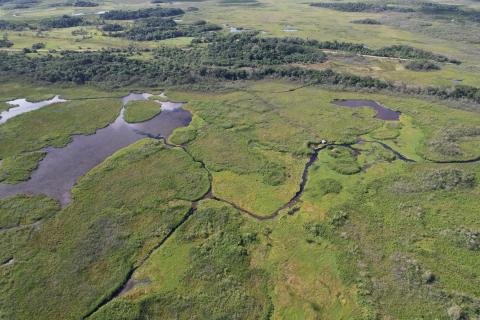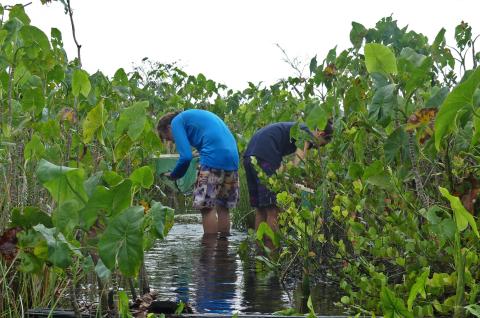Sepanguy
Located between the Iracoubo and Sinnamary rivers in French Guiana, the Pripris de Yiyi freshwater marshes extend over more than 20,000 hectares and are home to an exceptional biodiversity including manatees, dwarf caimans and green turtles, scarlet ibises, ospreys… Since 2013, giant otters (Pteronura brasiliensis) have been regularly observed in the area. Thanks to the support of Palmyre Conservation who financed the purchase of camera traps, the SEPANGUY has just started a detailed monitoring of this population.
Activities

The Pripris de Yiyi are owned by the Conservatoire du Littoral since 1996. They are managed by the municipality of Sinnamary and the association SEPANGUY who are both ensuring accessibility within the site: creation of interpretation trails and observatories for wildlife, organization of naturalist canoe trips.

The SEPANGUY association runs educational workshops and awareness activities with schoolchildren and the general public. It also carries out the scientific monitoring of many species and has initiated a research project aimed at improving the knowledge of the fauna and habitats of the Pripris in order to better preserve them.

The deployment of 20 camera traps near burrows and marking/resting areas that have been identified on the site will help the SEPANGUY to run a detailed study of the giant otter population that lives within this protected natural area while minimizing the disturbance of the animals. The study aims to determine the composition of the groups (the unique pattern of the white patches found on the animal’s throat allowing each individual to be precisely identified) as well as the factors influencing the presence of the species into the marshes. It will also enrich the territorial database on the species and raise public awareness about its ecology and protection.
Locally named “Tig Dilo”, the giant otter is listed as Endangered on the IUCN Red List.anger sur la Liste Rouge de l’UICN.
It was intensively hunted for its fur and was on the brink of extinction in the 70s. Even if some populations have recovered thanks to the ban on pelt trade and national protection laws, the giant otter remains severely threatened by the destruction of its habitat, overfishing, water pollution (due to gold mining, fossil fuel exploration and pesticides), diseases transmitted by domestic animals and mismanaged tourism.